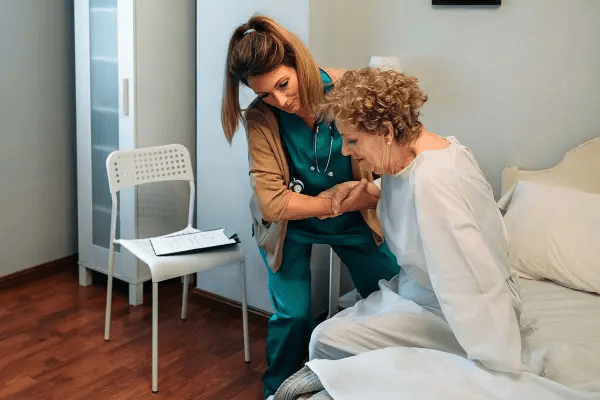
OTR’s Assessment Tool Shows Improving Patient Handling Leads to Better and Safer Outcomes for Patients and Care Providers
Teresa Boynton, an OTR from Colorado, developed the Bedside Mobility Assessment Tool (BMAT) so nurses could better determine patients’ current mobility status and safely handle them.

Teresa Boynton, MS, OTR, CSPHP
Independent Clinical Consultant, Mobility Consulting and Presentations, LLC
Location: Colorado
Certified in 1989
The OT Innovation
Studies have shown that adults who are ambulatory before a hospital admission spend up to 83% of their time lying down once in the hospital, and more than a third of adults 70 years and older are discharged from the hospital with a major new disability that was not present on admission. Mobilizing patients safely and consistently is not only a challenge during inpatient care but it’s also an important element in sustaining their progress.
Teresa Boynton, an OTR from Colorado, recognized the need for a mobility assessment tool that nurses could use to determine patients’ current mobility status and to help standardize safe patient handling and mobility (SPHM) equipment use, especially patient lifts. She met and networked with nurses from different hospitals to help develop, and later pilot, her idea. The outcome: the Bedside Mobility Assessment Tool (BMAT) 1.0 and BMAT 2.0.
With the BMAT, Teresa and her team aimed to improve outcomes by safely mobilizing patients early and often to decrease risks associated with immobility and the negative effects of bedrest, including falls. They also wanted to improve safety for care providers by guiding them to use appropriate safe patient handling and mobility practices and equipment in a standardized and consistent manner.
The BMAT 2.0, which takes about two minutes to complete, defines four levels of mobility (Sit and Shake, Stretch, Stand, and Step). Each level has a physical task aimed at assessing a patient’s strength, coordination, balance, tolerance, and ability to follow directions. When patients can perform the task, they advance to the next level; if they cannot, they stay at the current level.
“Safe patient handling and mobility practices supported by the BMAT lead to improved safety for patients and a safer work environment for care providers, as well as timely and appropriate referrals to OTs and PTs, and better outcomes.”
Teresa Boynton, MS, OTR, CSPHP
2020 NBCOT Innovation Award Winner
Producing Positive Results
Since being introduced in 2014, the BMAT has been implemented in hospitals across the U.S. as well as internationally. It is recognized as an assessment tool that promotes SPHM practice and improves quality of care and safety for care providers and patients.
Teresa and her team have witnessed many positive outcomes for patients and care providers using the BMAT, including:
- reduction in patient handling-related injuries to care providers;
- reduction in patient falls;
- improvement and consistency in use of SPHM equipment; and
- improvement in communication about patients’ mobility needs among rehab staff (OTRs, COTAs, PTs) and nurses.
